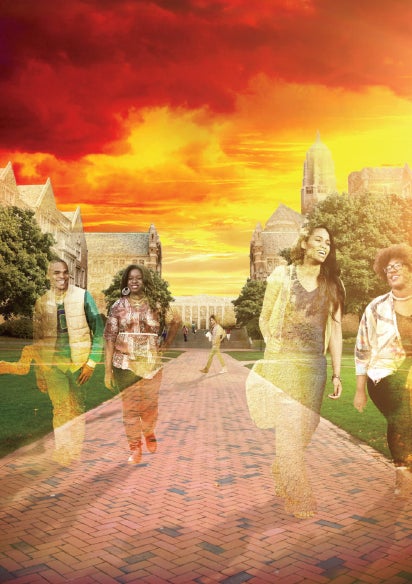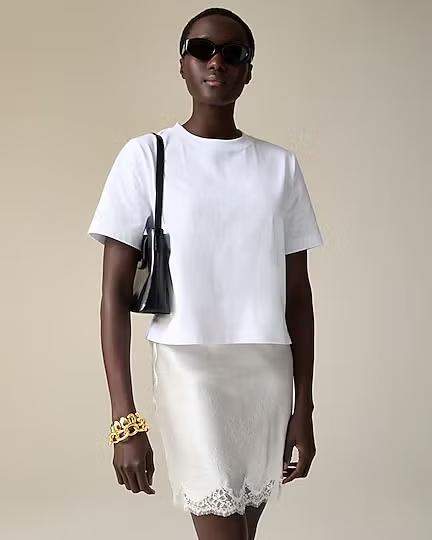
The following article is taken from the August 2013 issue of ESSENCE magazine. On news stands now!
If Crystal Autumn Brooks has her way, she will be headed to Howard University in August. Currently, just one of only five African-Americans among 70 students in Oakland Technical High School’s elite Paideia program, Crystal, 17, wants to attend Howard instead of a college “where I might see a Black person every other day or so.” Crystal has the will, but she’s way off from being able to afford Howard’s $41,000 annual cost of attendance. Currently, her financial aid package is $20,000; her mother, Darlene Brooks, was turned down for a Parent PLUS loan, which might have bridged the difference. The family has battled homelessness and unemployment in the past five years, with Darlene, who describes herself as a “writer and community volunteer,” functioning as the sole support for Crystal and her two younger sisters. “I want my daughters to have what they need,” Darlene says. “We’ve looked at other schools, and Crystal has applied to several, but Howard remains her first choice.” But if Crystal’s financial aid package isn’t augmented this summer, this young, gifted, Black Californian will have to seek an alternative.
We’ve all encountered a Crystal: a determined student who wants to enroll in and graduate from a historically Black college or university but can’t afford the tuition. Here’s something you may not know: Most college presidents and financial aid officers want to help students like Crystal. Indeed, historically Black colleges and universities (HBCUs) were founded to assist students with the kinds of financial challenges Crystal faces, but for a number of reasons, these days HBCUs have only so much scholarship money to spread around. Why? Most college scholarship support comes from interest on endowments, but the endowments of HBCUs, small to begin with, are shrinking in the face of current economic realities.
If the endowments of all 105 HBCUs were added up, they’d still amount to less than 10 percent of Harvard University’s endowment, which at upward of $30 billion is the wealthiest of any college in the world. By contrast, Clark Atlanta University has an endowment of $53 million. Some of the smaller HBCUs have endowments under $20 million. Bennett College for Women in Greensboro, North Carolina, for example, had an endowment of around $13 million when I stepped down as president in 2012. Livingstone College in Salisbury, North Carolina, about an hour’s drive from Bennett, had an endowment of less than $2 million. Add to this the recent changes in who can qualify for Parent PLUS loans and Pell Grants, and a byzantine accreditation process that penalizes schools for carrying too much debt, and one has to wonder, as I have, whether HBCUs are being fiscally strangled by bureaucratic red tape. In the face of such challenges, how will these cherished institutions continue to prepare future Black leaders?
As president of Bennett College for Women from 2007 to 2012, I was both amazed by the talent of our students and heartbroken by the financial challenges they encountered. At the beginning of a semester, not a day would go by without a student, dissatisfied by her financial aid award, seeking me out to intervene. Sometimes we were able to offer a payment plan. Sometimes we moved funds around so that a two-semester award could be applied to the first semester in the hope that other scholarships would come through for the spring. Too often I commiserated when a very capable student had to go home because there was simply not enough money.
Some students’ plight was compounded by family circumstances: A family illness that required not only her help but also her earnings. A death in the family that pulled a student home. The bottom line is that college presidents must juggle faculty, staff and student needs with not enough money. At Morehouse, president John Silvanus Wilson had been in office a scant three months when he had to close the campus and suspend pay for the spring break week to save money. I understood his pain. During my tenure I felt as if I had a muzzle on my mouth when I wanted to respond to some fiscal policy challenges and others did not agree. The fact is HBCUs are facing an uphill battle for funding that have left many fighting to survive.
Why HBCUs Lost 14,000 Students In A Year
You are a proud graduate of an HBCU. You donate money. You’re robustly involved in alumni activities. So why does your alma mater seem to be in a crisis? It’s simple and it’s complicated. First, HBCUs were especially challenged by recent changes in how Parent PLUS loans are dispensed. Parent PLUS loans are awarded based on a parent’s credit score, and, until academic year 2012–13, generally continued for a student’s four-year academic career. With little notice, in October 2011, the Department of Education tightened the application of credit rules, making it more difficult for parents with less-than-perfect credit reports to be approved for the loan.
“Parents will pay to keep their child in school,” says Marcia Fudge (D-OH), Congressional Black Caucus chair. “If they are paying their loan back in a timely way, missing a credit card payment or two should not cause them to be denied a continuing PLUS loan.” The 2011 change was a shock to many schools and to parents who had made timely payments on loans in the past. With so many families denied PLUS loans for the new school year, HBCUs lost a devastating 14,000 students all at once. Many newly admitted students could not matriculate as freshmen or transfers, while others had to drop out because they could not pay the full cost of attendance.
Take Mia Hollins for instance, a New Orleans native who hopes to attend Howard University in August. She received a Legacy Scholarship that covers her tuition, but is still $10,000 short of the full cost of attendance. While her mother, Lisa Hollins, an Amtrak customer service representative, earned too much for Mia to qualify for a Pell Grant, she was denied a Parent PLUS loan. She has been offered a $5,000 unsubsidized loan, and her mother is doing what she can to help, but the family’s finances have been scarred by their home loss during Hurricane Katrina. Mia has two options if she cannot raise the $10,000 she needs: She will either attend one of the other schools she has been admitted to (not an HBCU), or she will commute to Howard from Laurel, Maryland, where her aunt lives. The 23-mile, 45-minute commute may cost as much as $10 per day and reduce Mia’s opportunity to participate in campus activities.
One has to ask: How is it that Lisa Hollins was turned down for a Parent PLUS loan yet made too much money for her daughter to qualify for a Pell Grant? For academic year 2013–14, students from low-income families can qualify for as much as $5,645 in Pell Grants, but as the Pell is awarded on a sliding scale according to need, only those students whose families have incomes below $23,000 (reduced from $30,000) will receive the full grant. Tightening the belt even further, summer Pell Grants, which often helped students who needed to “catch up” from past deficiencies, were eliminated in 2011, while the limit on the number of semesters for which students could receive Pell Grants was lowered from 18 to 12.
Sacramento native Hershelle Gaffney graduated from Bennett College for Women in 2012 with $27,000 in debt, slightly above the average amount of student loan debt. The 2011–12 student body president says she was “aggressive” in seeking outside scholarships. She also says she feels fortunate to have found a job as an account manager right after college. “Many of my Bennett sisters didn’t get jobs right away, and they are frustrated by the intimidating nature of collection calls,” she notes. “They claim to have a six-month grace period and offer income-based repayment, but they start calling three months after you’ve graduated. People shouldn’t have to start paying their loans back until they find employment.” Hershelle could have attended lower-cost colleges, especially in the California state system, but a Black in America college special convinced her that Bennett was where she wanted to be. While she does not regret the loan she carries, she says that colleges should offer more grant aid, especially to outstanding students.
“There Is A Fear Of Black Intelligence”
Walter Kimbrough, 46, the seventh president of Dillard University, is popularly called the “hip-hop president” by students and colleagues. He is one of the nation’s youngest college leaders, having served eight years as president of Philander Smith College in Little Rock, Arkansas, before taking the helm at Dillard last year. He believes HBCUs are under siege. “There is a fear of a Black planet, or a fear of Black intelligence,” says Kimbrough. “Our colleges are repositories of Black knowledge, which some would like to ignore. We are plagued by low endowments but also by our nation’s indifference to our service. We prepare students for graduate and professional school. We take first-generation students and make them career-ready. High Black unemployment rates and lower Black wealth make it difficult for parents to help finance their child’s education, and we do our best to provide what the parents can’t. Yet because of the financial circumstances some of our students come from, some students get jobs while they are matriculating, and these jobs undermine their academic success. They feel an obligation to help at home, which may increase their loan indebtedness.”
Complicating matters for universities such as Dillard are deductions in federal education spending. Federal departments that contract and work with HBCUs have seen funding reduced by more than $115 million between 2010 and 2011. Yet Secretary of Education Arne Duncan extols the value of HBCUs. “If we are serious about the President’s goal of leading the world in graduation rates,” he says, “and if we are serious about giving young folks a path to middle class, I don’t think we can get there without the critical role HBCUs play in educating students of color.” Duncan and his team acknowledge that the stricter application of the Parent PLUS rules due to federal cuts and sequestration were poorly communicated. And he indicated that parents who were denied loans this year could possibly be approved if they reapply. But Duncan knows all too well that the situation is more complicated than reinstating PLUS loans, because when programs like Work-Study and other grants are cut by $51 million, that reduction in funding disproportionately affects HBCU students.
Even with these cuts, many schools continue to enroll students, or hold on to those on the verge of dropping out for financial reasons. The colleges may pay the price later when accrediting institutions, known for their focus on finances, may choose to penalize them because of the amount of debt they carry. The Southern Association of Colleges and Schools (SACS) accredits most HBCUs, as most are located in southern states. While the SACS denies any bias, Leonard Haynes, former interim president at Grambling University from 1997 to 1998 and former head of the White House Initiative on HBCUs, notes, “There is a perception that the SACS has a bias against small schools, and those with lower endowments. Many of these are HBCUs.”
My own experience as the president of Bennett College for Women confirms this perception, given that we received a SACS sanction in the same year that we built four new buildings because a donor defaulted on a pledge. Accrediting organizations like the SACS (there are five others that deal with non-southern states) play a key role in the survival of HBCUs and other colleges. Without accreditation, colleges cannot process federal or state financial aid for students, and credits from an unaccredited institution may not be transferable. The SACS can put colleges on warning, probation or “show cause,” meaning the schools must make the case for why they should stay open. Working with SACS and other accrediting agencies can be like trying to roll a pea uphill—a daunting undertaking for presidents who have inherited challenging financial situations and are trying to improve them.
Success in this endeavor is never guaranteed: Paul Quinn College in Dallas, for example, was dropped from SACS membership in 2009 because of concerns about “finances and institutional effectiveness.” President Michael Sorrell gained accreditation from the Transnational Association of Christian Colleges, but without SACS accreditation, Paul Quinn is no longer a member of the UNCF.
Similarly, St. Paul’s College in Lawrenceville, Virginia, announced in May that it would close on June 30,2013. The SACS had denied reaffirmation of St. Paul’s accreditation because the association deemed the institution insufficiently financed, even after the college raised more than $5 million in six months. St. Paul’s appealed the accreditation decision in court and explored merger options to keep the school open. Instead it is closing, though administrators say the closure may be temporary.
“I Think It’s Racist To Ask About The Relevance Of HBCUs”
With its unique mission to prepare and secure the next generation of Black achievers, HBCUs must lobby federal departments just to ensure that their funding stays level or rises. Every year this effort raises questions about the relevance of HBCUs. “Southern legislators, from both sides of the aisle, understand HBCUs,” says Lezli Baskerville, president of the National Association for Equal Opportunity in Higher Education. “But others who play a role in these funding decisions continue to ask us to justify our existence.”
Marybeth Gasman, a White University of Pennsylvania professor who has studied and written about HBCUs, says, “I think it is racist to ask about the relevance of HBCUs,” but adds that HBCUs have to do a better job of telling their story. Bill Spriggs, an economics professor at Howard University, agrees. “Part of this has to do with inequality, which has not been fully dealt with in our nation,” he observes. “We don’t tell the stories of our success well enough. Students who graduate from Howard University earn more than those from the elite Williams College.” And Howard University has produced its share of luminaries, including Toni Morrison, who went on to win a Nobel Prize in Literature, the Pulitzer Prize for Fiction and a Presidential Medal of Freedom, among many other awards. “No one should ever question our relevance,” says Spriggs.






Of course, no conversation about HBCUs is complete without considering many of our college’s resistance to change. Some staff have a “that’s the way it’s always been done” mentality. And while PWIs (predominantly White institutions) such as Princeton have an alumni giving rate of 60 percent, HBCU giving rates generally fall below 10 percent. Some cite financial challenges in the African-American community as a reason for the lower rates, but Morehouse president emeritus Robert Franklin says, “With all of the Black wealth out there and the huge gifts some colleges have received from African-Americans, one would think that our institutions, also, should receive these gifts.” But no individual donor has yet exceeded Bill and Camille Cosby’s $20 million gift to Spelman in 1988.
Beyond donations, there is the upcoming Supreme Court ruling on affirmative action to consider. If it is struck down, some PWIs may feel less compelled to reach out to our students. And with many states cutting back on their contributions to public colleges, private HBCUs may become colleges of last resort for some students. Both the school and student will likely benefit. “HBCUs graduate half of the African-American K-12 teachers and 40 percent of the African-American STEM [science, technology, engineering and mathematics] graduates,” says Baskerville. Sixty percent of the African-Americans who get Ph.D.’s in STEM areas attended an HBCU undergraduate school.”
It is my experience that many inner-city students with average high school grades thrive and achieve at HBCUs, in part because of the quality of teaching but also because the environment is uniquely supportive of them. It’s why I believe HBCUs are needed now more than ever in our history. “Bennett College has prepared me for every challenge I could possibly face,” sums up Hershelle Gaffney. “It is where I became the woman that I wanted to be.”







